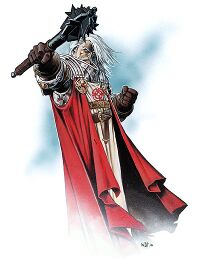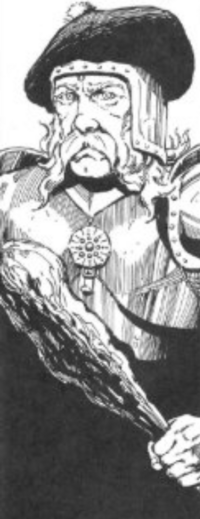Saint Cuthbert: Difference between revisions
1d4chan>QuietBrowser Going to start posting the Infobox in all the God articles we have; I'll let the experts fill those in. |
1d4chan>Biggus Berrus No edit summary |
||
| Line 1: | Line 1: | ||
{{dnd-stub}} | {{dnd-stub}} | ||
[[Image:Cuthbert p92.jpg| | [[Image:Cuthbert p92.jpg|200px|thumb|left|Saint Cuthbert The Cudgel, pictured with his cudgel. Not to be confused with [[Rogal Dorn]].]] | ||
{{Infobox Deity | {{Infobox Deity | ||
|Name = | |Name = Kord | ||
|Symbol = | |Symbol = | ||
|Alignment = | |Alignment = Lawful Neutral | ||
|Divine Rank = | |Divine Rank = 15 | ||
|Pantheon = | |Pantheon = Flanaessian | ||
|Portfolio = | |Portfolio = Retribution, common sense, wisdom, zeal, honesty, truth, discipline | ||
|Domains = | |Domains = Destruction, Law, Protection, Strength | ||
|Home Plane = | |Home Plane = The Bastion of Law, Abellio, [[Arcadia]] | ||
|Worshippers = | |Worshippers = Judges, constables | ||
|Favoured Weapon = | |Favoured Weapon = [[Mace]], specifically the cugel. | ||
}} | }} | ||
God of common sense, wisdom, zeal, honesty, truth, and discipline. | God of common sense, wisdom, zeal, honesty, truth, and discipline. | ||
| Line 28: | Line 26: | ||
The Billets are the most numerous of Saint Cuthbert's clergy. Most are lawful good, and they seek to minister to and protect the faithful. These are well-beloved by the common folk. Their symbol is a wooden club. The Chapeaux often come into conflict with the Billets, because the former order wants to seek new converts while the latter wants to care for the worshipers they already have. | The Billets are the most numerous of Saint Cuthbert's clergy. Most are lawful good, and they seek to minister to and protect the faithful. These are well-beloved by the common folk. Their symbol is a wooden club. The Chapeaux often come into conflict with the Billets, because the former order wants to seek new converts while the latter wants to care for the worshipers they already have. | ||
[[Image:2e Saint Cuthbert.png|200px|thumb|right|How older players remember him. ]] | |||
In real life, Saint Cuthbert is the patron saint of Northumbria (that's northern England, for all you non-Britfags in the audience) in the Anglican and [[Imperium|Catholic]] faiths. In older fluff, it was implied that he really ''was'' Saint Cuthbert, and that he somehow ended up in Greyhawk and was worshiped there. Strangely, this completely escaped TSR when the moral panics made them scrub D&D of all references to real-world Christianity in Second Edition. Probably because no one who isn't a devout Catholic or Anglican from Northumbria (or, apparently, Gary Gygax) has ever heard of Saint Cuthbert. | In real life, Saint Cuthbert is the patron saint of Northumbria (that's northern England, for all you non-Britfags in the audience) in the Anglican and [[Imperium|Catholic]] faiths. In older fluff, it was implied that he really ''was'' Saint Cuthbert, and that he somehow ended up in Greyhawk and was worshiped there. Strangely, this completely escaped TSR when the moral panics made them scrub D&D of all references to real-world Christianity in Second Edition. Probably because no one who isn't a devout Catholic or Anglican from Northumbria (or, apparently, Gary Gygax) has ever heard of Saint Cuthbert. | ||
{{D&D-Greyhawk-Deities}} | {{D&D-Greyhawk-Deities}} | ||
Revision as of 12:35, 1 October 2017

| Kord | ||
|---|---|---|
| Alignment | Lawful Neutral | |
| Divine Rank | 15 | |
| Pantheon | Flanaessian | |
| Portfolio | Retribution, common sense, wisdom, zeal, honesty, truth, discipline | |
| Domains | Destruction, Law, Protection, Strength | |
| Home Plane | The Bastion of Law, Abellio, Arcadia | |
| Worshippers | Judges, constables | |
| Favoured Weapon | Mace, specifically the cugel. | |
God of common sense, wisdom, zeal, honesty, truth, and discipline.
He is a Lawful neutral intermediate Deity from Greyhawk who is thought to have been human once. His favored weapon is the mace both heavy and light. Some sources also have him being lawful good. In reality he is a lawful neutral deity who tolerates lawful good more than lawful evil since they're not as likely to break the Law.
His first published appearance is in the module "The Village of Hommlet", which is the prologue to the famous Temple of Elemental Evil adventure. He was depicted as an older, stocky man, whose idea of doing good was to beat the evil out of people with a big stick -- a lot more tough-love than your typical paragon of lawful-good.
Saint Cuthbert's priesthood is divided into three major orders.
The Chapeaux, whose symbol is a crumpled hat, seek to convert people into their faith. They are equally divided between lawful good and lawful neutral characters. Paladins of Saint Cuthbert, known as Votaries or Communicants, have an honorary position in the Order of the Chapeaux. Their role is not just to convert others, but to actually fight enemies of the faith.
The Stars, whose symbol is a starburst, seek to enforce doctrinal purity among those already dedicated to the saint. Most are lawful neutral, and they do not shy from using mind-reading magic in order to ensure that even the private thoughts of their flock are pure.
The Billets are the most numerous of Saint Cuthbert's clergy. Most are lawful good, and they seek to minister to and protect the faithful. These are well-beloved by the common folk. Their symbol is a wooden club. The Chapeaux often come into conflict with the Billets, because the former order wants to seek new converts while the latter wants to care for the worshipers they already have.

In real life, Saint Cuthbert is the patron saint of Northumbria (that's northern England, for all you non-Britfags in the audience) in the Anglican and Catholic faiths. In older fluff, it was implied that he really was Saint Cuthbert, and that he somehow ended up in Greyhawk and was worshiped there. Strangely, this completely escaped TSR when the moral panics made them scrub D&D of all references to real-world Christianity in Second Edition. Probably because no one who isn't a devout Catholic or Anglican from Northumbria (or, apparently, Gary Gygax) has ever heard of Saint Cuthbert.